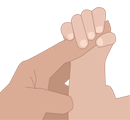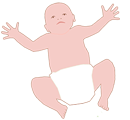Development of physical abilities
The newborn has a number of innate reflexes. These instinctive behaviours support the initial needs of the baby, for example suckling or responding to sudden noises or movements with a startle reflex.
Over the first few weeks of life, these decrease as the baby develops muscle tone and learns to use and control their movements. By 6 months, a baby is able to sit with support and by a year can typically stand, bearing their weight through their legs and maybe starting their first independent steps. Alongside these large or gross motor movements, an ability to control fine movement is also developing. This allows such activities as gripping and manipulating objects, then learning to scribble, draw and eventually write.
Rooting
Between 0-3 months of age, babies learn to turn when someone speaks to them and smile when they hear a voice. In fact, they seem to recognise familiar voices and will quieten to the sound of that voice. Babies under 3 months will also stop their activity and attend closely to the sound of an unfamiliar voice. They will often respond to comforting tones whether the voice is familiar or not.
They listen to the speech of those close to them and startle or cry if there is an unexpected noise. Loud noises wake them and they become still in response to new sounds.
Grasping
If the baby's palm is stroked, they will make a fist around the finger doing the stroking. This is known as the grasping reflex.
Startle (Moro)
A Startle, or Moro reflex, is triggered when the baby is either moved suddenly or if a loud noise, such as a clap, occurs suddenly. The reflex is to arch the back and extend the arms, fingers and legs. The head also falls back.
Walking
Holding the baby, such that their feet touch the floor, will induce a walking reflex. The baby will automatically make step-like motions with alternate feet.



